Physical Address
304 North Cardinal St.
Dorchester Center, MA 02124
(see Fig. 14.1A–H )
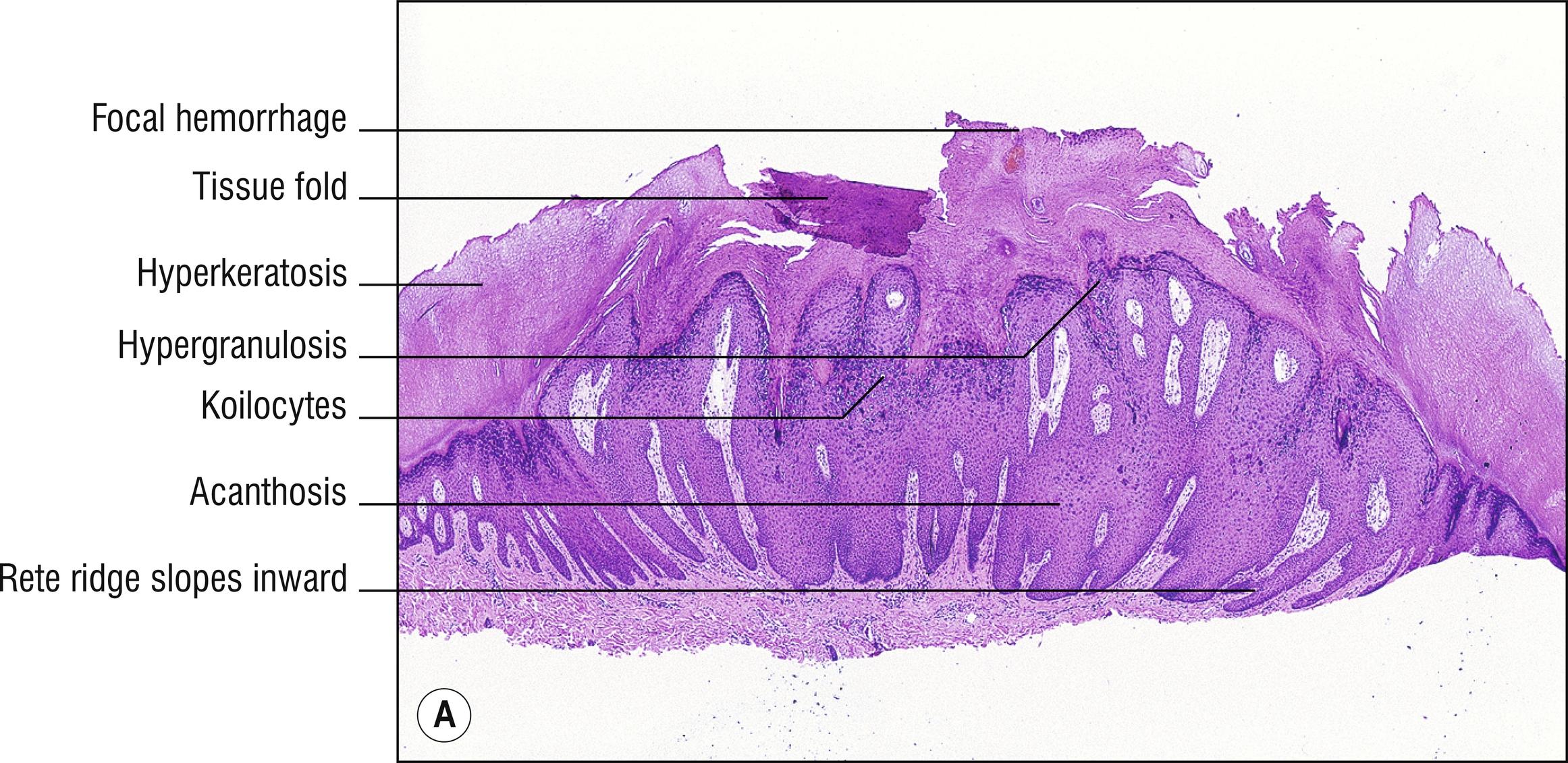
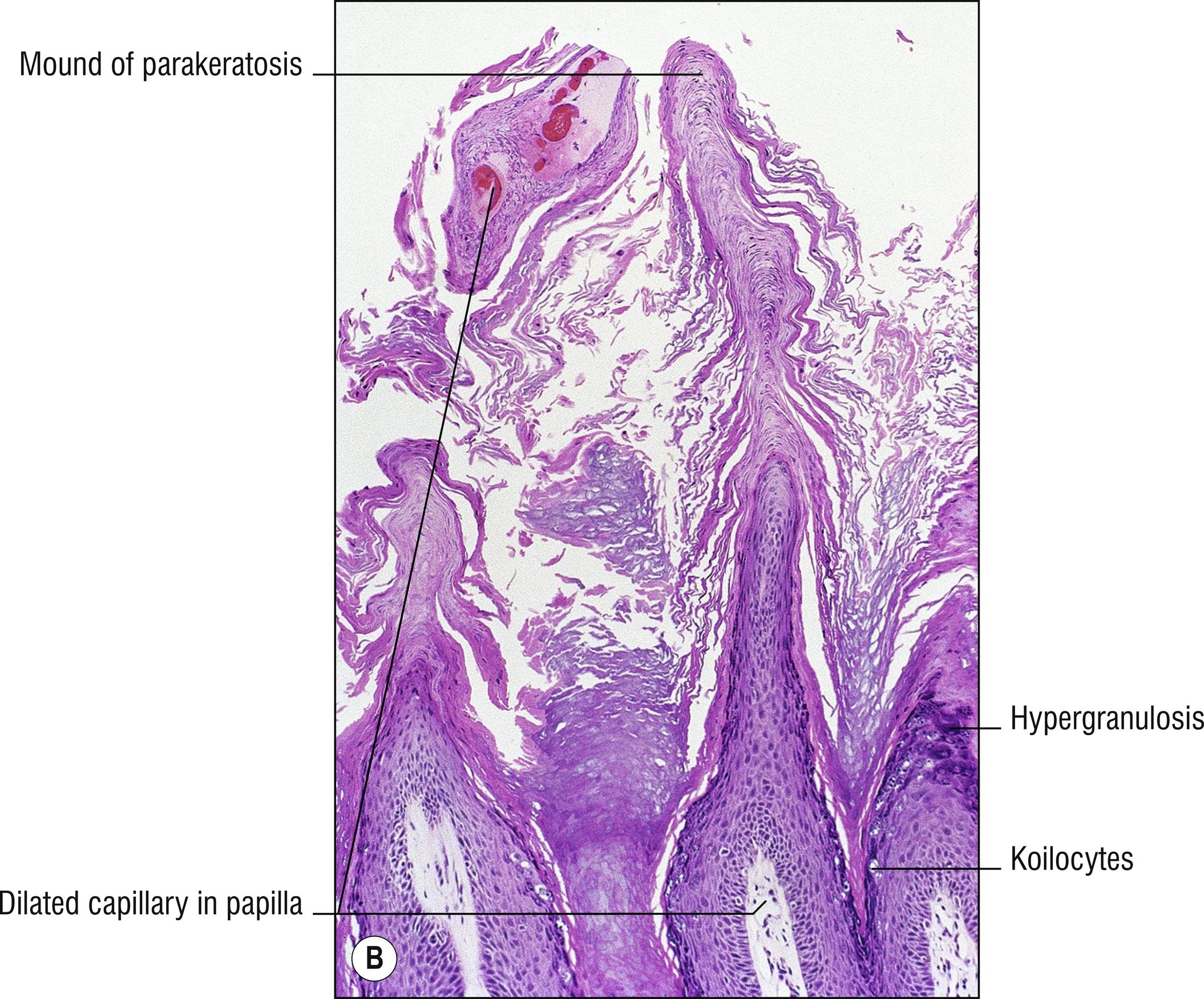
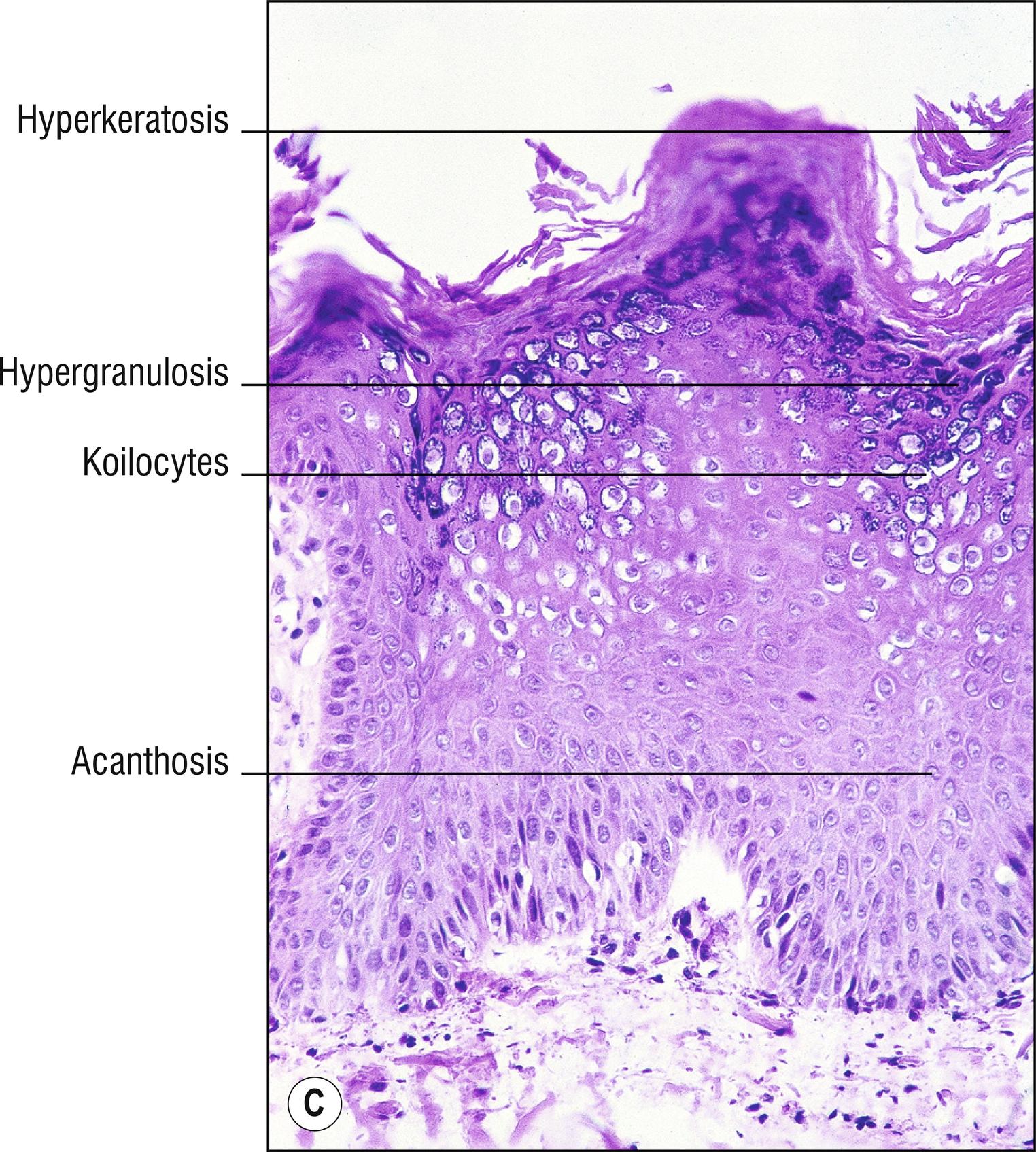
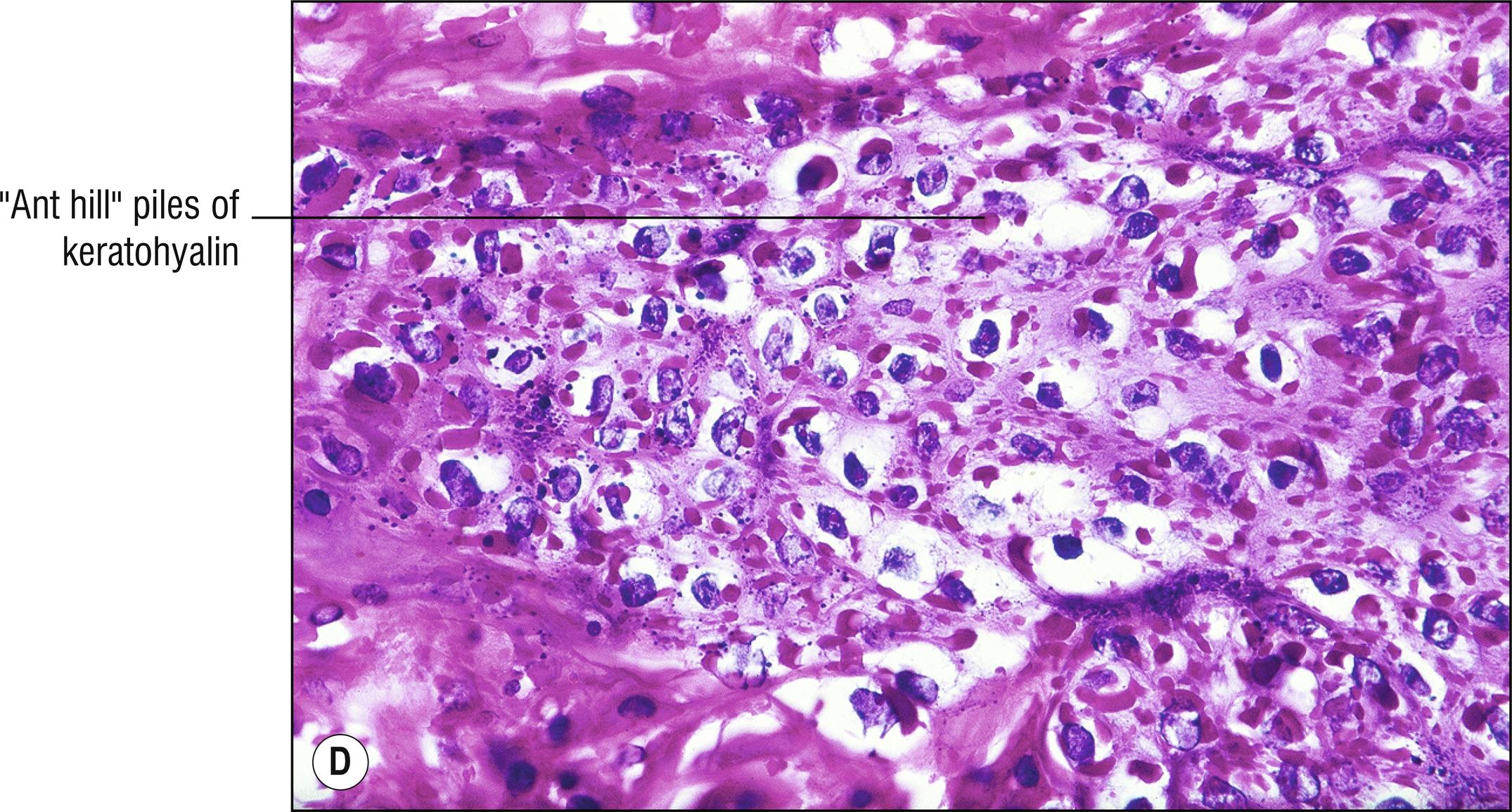
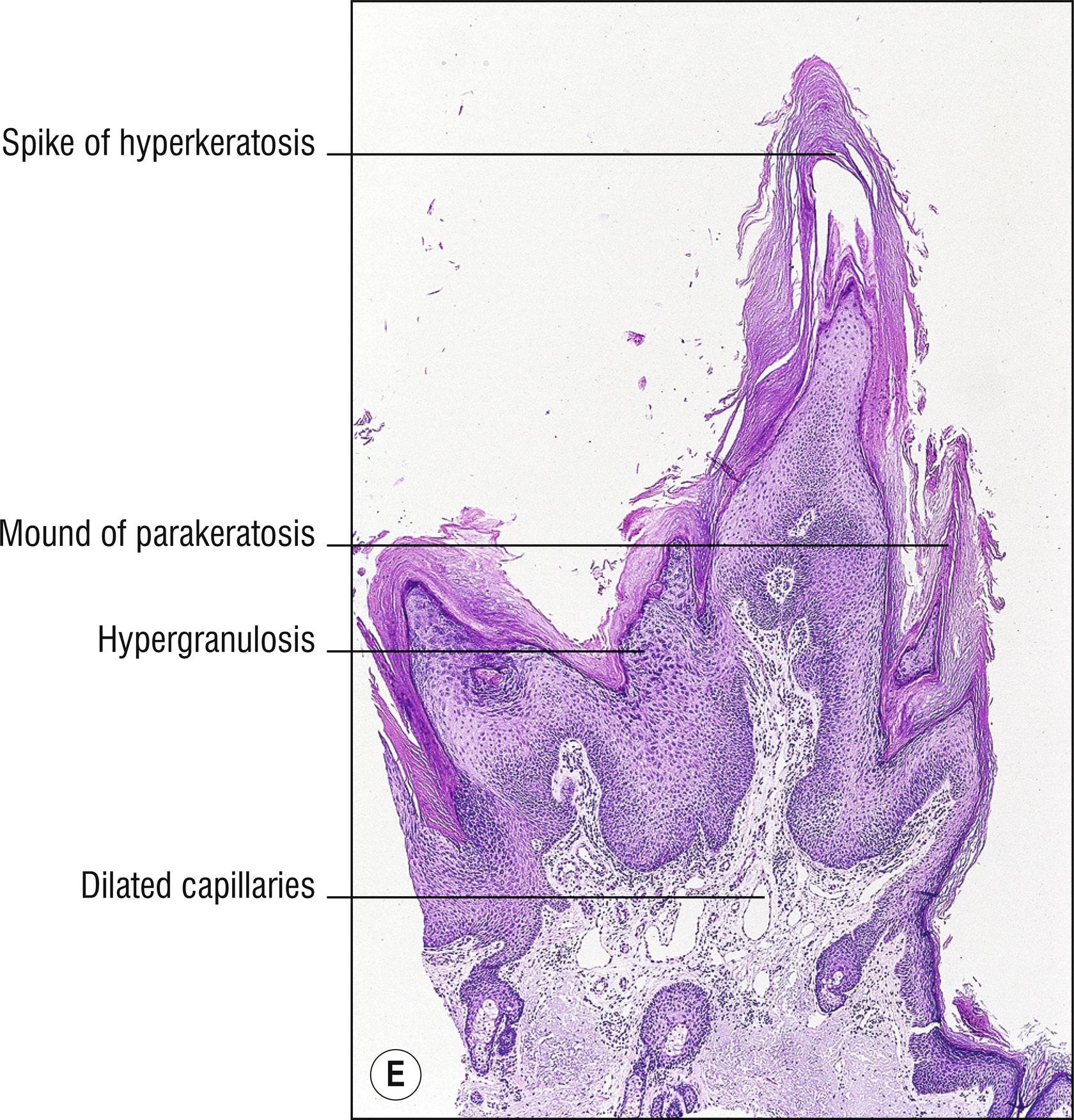
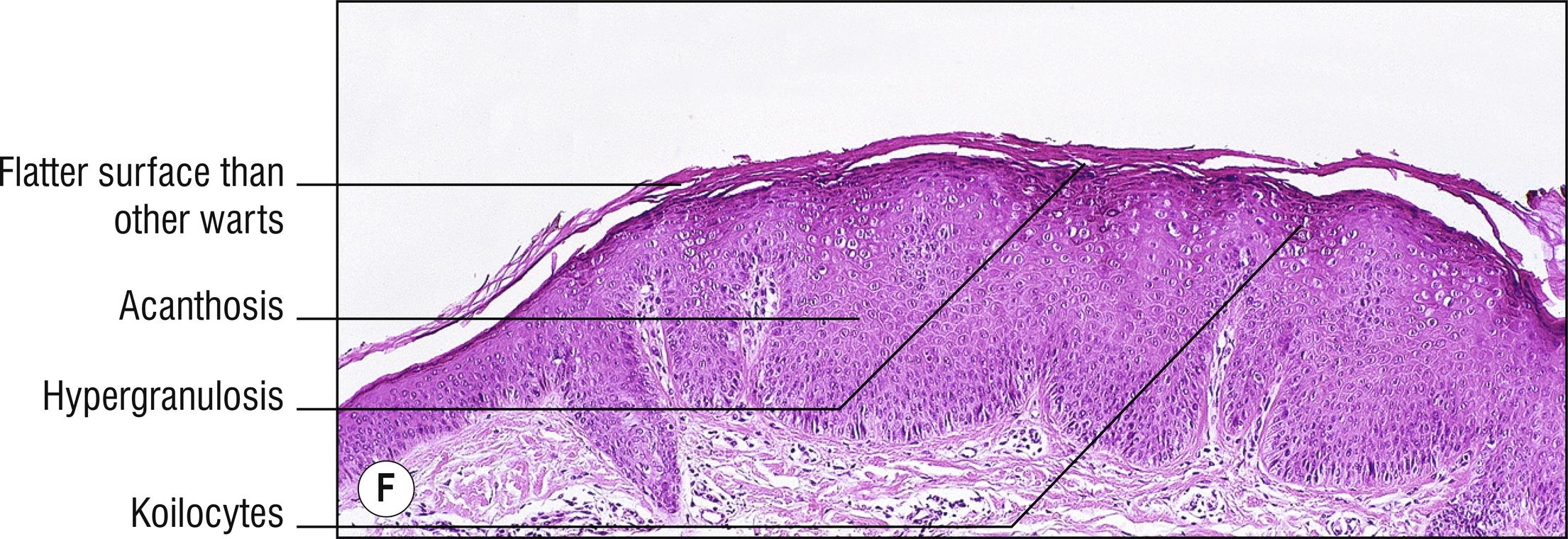
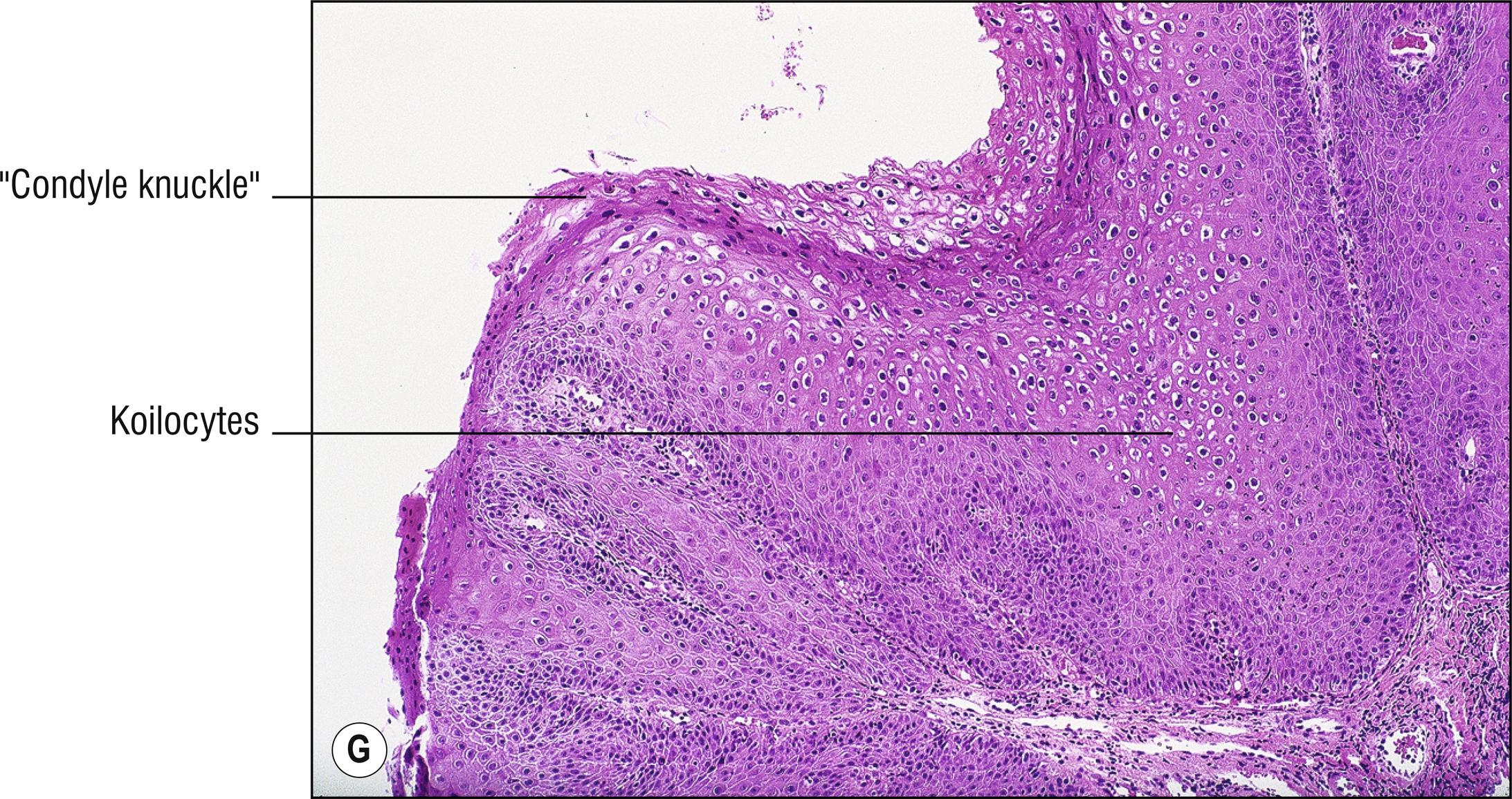

Verrucous papules (1.146) due to infection with HPV, of which there are more than 60 subtypes. Warts often bend the dermatoglyphic lines and may have black dots representing thrombosed capillaries in dermal papillae (so-called “seeds” in a “seed wart”).
Hyperkeratosis (1.61), papillomatosis , hypergranulosis (1.60)
Columns of parakeratosis (1.104), especially over projecting dermal papillae
Vacuolated superficial keratinocytes with pyknotic raisin-like nuclei ( koilocytes ) sometimes
Rete ridges often slope inward at borders of lesion ( arborization, toeing inward ), sometimes giving the lesion a spread-fingers appearance
Dilated capillaries in dermal papillae
Perivascular lymphocytes (1.109)
Verruca vulgaris (VV): the common wart, commonly HPV-2, most common on acral skin of the hands and fingers (1.56). The vulgaris can be left off, except this is used in dermatology to indicate the common prototype of certain disorders (acne vulgaris, lupus vulgaris, psoriasis vulgaris, pemphigus vulgaris, ichthyosis vulgaris, etc).
Plantar wart: located on plantar aspect of the foot (1.48), commonly HPV-1, less papillomatosis, more hypergranulosis.
Myrmecia wart: “ anthill wart “ (Myrmicinae is the subfamily name for fire ants) with tremendous mounds of hypergranulosis and koilocytes resembling specks of dirt of an anthill, HPV-1, mostly on soles and toes.
Filiform wart: more extreme delicate papillomatosis, more on the face.
Verruca plana (flat wart): children or young adults, often face, legs (spread by shaving), commonly HPV-3, often multiple, papules less than 4 mm in diameter with flat-topped smoother surface, may be subtle, minimal papillomatosis and no parakeratosis.
Condyloma acuminatum (venereal wart, plural is condylomata acuminata): genital warts , found on the penis (1.107), vulva (1.149), or groin (1.55), commonly due to low risk HPV-6 and 11 (most common), and 42, 43, and 44. Less often related to oncogenic high risk types 16, or18 (most common), and 31, 33, 35, 39, 45, 51, 52, 56, 58, 59, and 68 which may evolve to Bowen’s disease or bowenoid papulosis (below). Less hyperkeratosis than ordinary warts, more massive acanthosis, and more gentle papillomatosis instead of pointed projections (condyloma means “fist” or “knuckle”). See related discussion of LSIL and HSIL (18.8), Bowen’s disease (18.10) and p16 ( Chapter 30 ). Don’t use the word condyloma by itself because the less common condyloma lata is a completely different entity (12.13). HPV typing by PCR or in situ hybridization can be done from paraffin embedded tissue when it is questionable whether a genital lesion is HPV-induced or not, but technical problems are common, so a negative result might be viewed with skepticism when HPV is strongly suspected. About 40% of vulvar warts in children are thought not likely to be related to sexual abuse, when HPV-2 is found instead of the other types. On adult vulvas, HPV-2 is rare. HPV typing can thus become evidence in legal battles or child abuse accusations.
Condyloma acuminatum after podophyllin application: a pseudomalignancy (1.118), many mitoses arrested in metaphase , which may resemble squamous cell carcinoma or bowenoid papulosis.
Epidermodysplasia verruciformis (EDV): familial (inactivated EVER1 or EVER2 genes) or acquired cellular immunity defect, warts become confluent, mostly HPV-5 or 8 and less commonly many other types, may clinically resemble tinea versicolor or pityriasis rosea (2.4), often bubbly bluish cytoplasm in keratinocytes, sometimes cytologic atypia (hyperchromatic pleomorphic cells), may evolve to squamous cell carcinoma.
Bowenoid papulosis (18.10): condyloma acuminatum in which bowenoid changes are found, often multiple and more brownish papules , more sessile and less acuminate, usually due to HPV-16, -18, or other oncogenic strains, a euphemism for squamous cell carcinoma in situ, but is not usually aggressive. This term is favored by dermatologists who wish to downgrade the significance of these lesions as carcinoma in situ, so that conservative local destruction can be justified. The name is not favored by most gynecologists, gynecologic pathologists, or urologists, some of whom do therapy that is too aggressive.
Pruritic vulvar squamous papillomatosis: small , itchy , subtle papules of the labia minora (1.149), which may appear normal, with variable koilocytic changes, lichenification, submucosal edema, and perivascular lymphocytes, polymerase chain reaction (PCR) may be needed to find HPV, which may not be the cause in all cases.
Focal epithelial hyperplasia (Heck’s disease): HPV-13 or -32 produces multiple papules on the mucosal lip (1.74) or elsewhere in the mouth (1.82), often familial in patients with Native American heritage .
Squamous papilloma: a term used for HPV infection (usually HPV-6 or -11) on mucosal surfaces, such as the conjunctiva, tongue, pharynx, larynx, esophagus, vagina, or anal canal.
Other papillomas (1.102) do not have koilocytes, but this may be confused with other causes of epidermal vacuolization (1.144). Electron microscopy, immunoperoxidase staining, or molecular genetic techniques may be needed if proof of HPV is desired.
Verrucous carcinoma (18.11) is more massive, and bowenoid papulosis (18.10) has more mitoses and cytologic atypia.
Other causes of keratinocyte vacuolization (1.144).
(see Fig. 14.2A–D )




These two herpes viruses are common, and present as painful grouped vesicles on an erythematous base, later becoming crusted or ulcerated (1.142). The virus then becomes latent in the nerve ganglion cells. Herpes simplex most commonly occurs on the penis (1.107), vulva (1.149), buttock , lip (1.74), or face (1.44). Severe extensive primary involvement of the mouth is herpetic gingivostomatitis . Dissemination in eczema patients is called eczema herpeticum ( Kaposi varicelliform eruption ). Involvement of the finger is herpetic whitlow . Recurrences in the same location are common. Varicella ( chickenpox ) is spread through the respiratory route, and presents in childhood as an acute febrile illness with pharyngitis, vesicles in the mouth, and generalized vesicles, beginning centrally, and spreading peripherally (C-P, C hicken P ox, C entral to P eripheral). The virus then typically remains dormant for years or forever. A single recurrence may occur many years later as shingles ( zoster ), with unilateral vesicles in a dermatome , often purpuric (1.120), most common on the trunk or face . Subsequent recurrences are very rare unless there is immunosuppression. Vccines for varicella zoster are now widely available. The diagnosis of both types of herpes virus is usually made clinically, or with cultures , fluorescent antibody smears , or Tzanck smears .
HSV and VZV cannot be distinguished with routine H&E staining
Intraepidermal vesicle or ulceration may not be present in early lesions
Epidermal necrosis and ballooning degeneration : herpetic cytopathic changes are enlarged and pale keratinocytes, with steel-gray nuclei , margination of chromatin at the edge of the nucleus, sometimes with pink intranuclear inclusions surrounded by an artifactual cleft (Cowdry type A inclusions, Lipschutz bodies), acantholysis , or multinucleated keratinocyte formation
Extravasated erythrocytes often (1.40)
Perivascular or diffuse lymphocytes or neutrophils, sometimes with changes of leukocytoclastic vasculitis (4.1)
Eczema herpeticum: eczema (2.1) becomes secondarily infected with herpes virus.
Ballooning degeneration to a lesser degree can sometimes be seen in smallpox or vaccinia (14.3) and orf or milker’s nodule (14.5), but multinucleated keratinocytes are rarely seen, and inclusion bodies, if found, are more likely to be intracytoplasmic.
Other acantholytic diseases (1.2) or those with necrotic keratinocytes (1.86).
Other diseases with intraepidermal vesicles (1.147, Chapter 5 ).
Other genital ulcers (12.13).
(see Fig. 14.3 )

Smallpox (variola), a deadly disease, has been eradicated due to vaccination with the vaccinia virus (mutant of cowpox). Rare disseminated skin infections are seen with the vaccinia virus in patients with eczema ( eczema vaccinatum ). Patients with immunodeficiency may also develop dissemination, or the vaccination site may fail to heal. Routine vaccination has now been largely discontinued, except in military personnel, due to the potential use of smallpox in biological warfare.
Intraepidermal vesicles (1.147) with few balloon cells (usually not multinucleated) and inclusion bodies that are primarily intracytoplasmic (Guarnieri bodies)
Mixed diffuse dermal infiltrate of lymphocytes and neutrophils
Herpes simplex and varicella zoster (14.2) exhibit more multinucleated giant cells and the inclusion bodies are intranuclear.
(see Fig. 14.4A,B )


Very common white (1.150) umbilicated papules , common on penis (1.107), vulva (1.149), or groin (1.55) as a sexually transmitted disease. Children acquire infection from close contact or swimming pools, with lesions on the eyelids , face , trunk , and axilla . It is a poxvirus. The diagnosis is usually made clinically, but inflamed red lesions are more difficult to recognize, and are more likely to be biopsied, especially when large or solitary. Widespread lesions can occur with atopic dermatitis, immunosuppressive therapy, or HIV infection. Usually infection is self-limited, resolving in 6 months to years.
Epidermal hyperplasia producing a crater filled with molluscum bodies (Henderson–Patterson bodies) that are huge, up to 35 microns, eosinophilic to basophilic intracytoplasmic inclusions that push the nucleus and numerous keratohyaline granules aside
Intact lesions show little or no inflammation, while ruptured lesions exhibit a dense mixed inflammatory response consisting of mononuclear cells, neutrophils, and multinucleated giant cells. Rarely, CD30 + atypical reactive lymphocytes resemble lymphoma.
The diagnosis is obvious once molluscum bodies are identified, but they may be sparse in some densely inflamed lesions. Rarely molluscum might be confused with warts (14.1).
(see Fig. 14.5A,B )


These two parapox viruses cause hemorrhagic crusted blisters , pustules, or plaques on the fingers and hands (1.56). The H&E and electron microscopic findings of orf and milker’s nodule are identical, so they are distinguished by history. Orf (ecthyma contagiosum) is acquired from handling infected sheep (especially scabby mouth in lambs), and milker’s nodules from cows (especially the udders). The virus can live on fenceposts or soil for at least 6 months, so there may not be an obvious exposure to animals. Lesions resolve in about 6 weeks. The viruses do not grow in routine culture.
Histology varies greatly depending on the age of the lesion
Vacuolated superficial epidermis (1.144) with inclusion bodies that are predominantly intracytoplasmic , occasionally intranuclear
Epidermal necrosis , often with extremely delicate finger-like projections into the dermis
Dense , diffuse , mixed inflammatory infiltrate in the dermis
Dermal edema (1.30), extravasated erythrocytes (1.40), dilated blood vessels
Become a Clinical Tree membership for Full access and enjoy Unlimited articles
If you are a member. Log in here